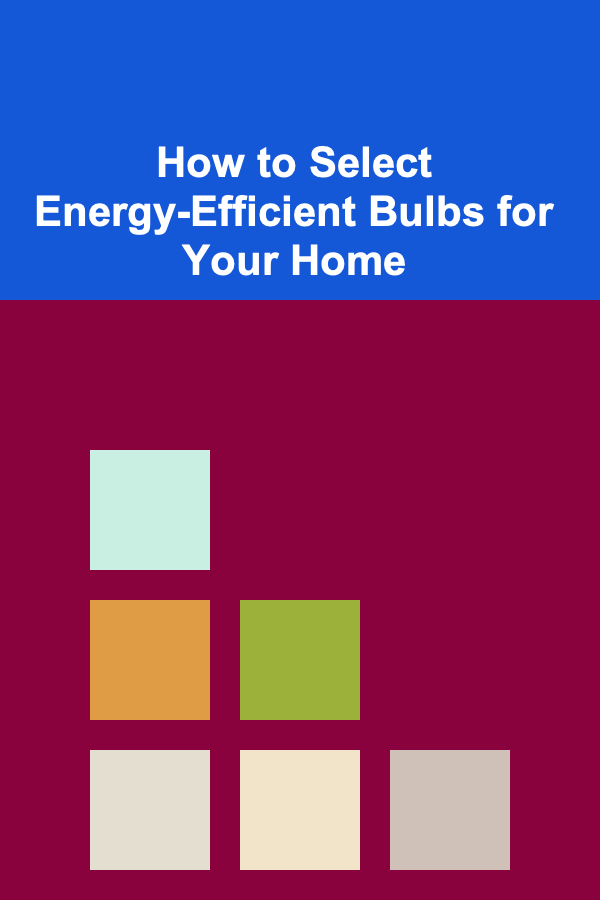
How to Select Energy-Efficient Bulbs for Your Home
ebook include PDF & Audio bundle (Micro Guide)
$12.99$9.99
Limited Time Offer! Order within the next:

As awareness of environmental issues and energy consumption continues to rise, many homeowners are looking for effective ways to reduce their energy usage. One of the simplest yet most impactful changes you can make is switching to energy-efficient light bulbs. Not only do these bulbs help lower your electricity bills, but they also contribute to a greener planet. This comprehensive guide will delve into the various types of energy-efficient bulbs available, how to select the right one for your home, and tips for maximizing their benefits.
Understanding Energy Efficiency in Lighting
What Are Energy-Efficient Bulbs?
Energy-efficient bulbs are designed to provide the same amount of light (measured in lumens) as traditional incandescent bulbs while consuming significantly less energy. The most common types of energy-efficient bulbs include:
- Compact Fluorescent Lamps (CFLs): These bulbs use about 70% less energy than incandescent bulbs and have a longer lifespan.
- Light Emitting Diodes (LEDs): Known for their extreme efficiency, LEDs can use up to 80% less energy compared to incandescent bulbs, and they last much longer.
- Halogen Bulbs: A type of incandescent bulb that is slightly more efficient than standard incandescent bulbs but not as energy-saving as CFLs or LEDs.
Why Choose Energy-Efficient Bulbs?
- Cost Savings: While the upfront cost of energy-efficient bulbs may be higher, they save money over time through reduced energy bills due to their lower wattage.
- Longer Lifespan: Energy-efficient bulbs generally last much longer than traditional incandescent bulbs, reducing the frequency and cost of replacements.
- Environmental Impact: Using less energy reduces greenhouse gas emissions associated with electricity production, contributing to a healthier planet.
- Variety of Options: There is a wide range of styles and color temperatures available, allowing homeowners to choose bulbs that fit their specific needs and preferences.
Types of Energy-Efficient Bulbs
Understanding the different types of energy-efficient bulbs is essential when selecting the right option for your home.
1. Compact Fluorescent Lamps (CFLs)
CFLs are spiral-shaped and typically fit into standard light fixtures. They use approximately 15 watts of energy to produce the same light output as a 60-watt incandescent bulb.
-
Pros:
- Lower energy consumption
- Longer lifespan (10,000 hours on average)
- Available in a variety of shapes and sizes
-
Cons:
- Contains small amounts of mercury, requiring careful disposal
- May take time to warm up to full brightness
- Some users find the light quality less pleasant compared to incandescent bulbs
2. Light Emitting Diodes (LEDs)
LEDs are solid-state lighting products that use semiconductor materials to convert electricity into light. They have become increasingly popular due to their efficiency and versatility.
-
Pros:
- Extremely energy-efficient (uses about 8-12 watts for similar light output as a 60-watt bulb)
- Exceptional lifespan (up to 25,000 hours or more)
- Immediate full brightness without warm-up time
- Available in various colors and designs
-
Cons:
- Higher initial cost compared to other options
- Some cheaper LED options may have inconsistent quality
3. Halogen Bulbs
Halogen bulbs are a type of incandescent bulb that uses halogen gas to increase brightness and efficiency. They consume about 20-30% less energy than traditional incandescent bulbs.
-
Pros:
- Bright, white light that closely resembles natural daylight
- Dimmable and compatible with many existing fixtures
- Quick startup time
-
Cons:
- Shorter lifespan compared to CFLs and LEDs (about 2,000 hours)
- Produces more heat than other energy-efficient options, which can be a fire hazard if used improperly
Factors to Consider When Selecting Energy-Efficient Bulbs
When choosing energy-efficient bulbs, several factors should influence your decision:
1. Brightness (Lumens)
Brightness is measured in lumens rather than watts. When selecting bulbs, consider the desired brightness for each room.
- General Guideline :
- For a standard living area, aim for 2,000-3,000 lumens.
- For dining rooms, 3,000-6,000 lumens can create an inviting atmosphere.
2. Color Temperature
Color temperature is measured in Kelvin (K) and determines the appearance of the light produced by a bulb. Different color temperatures can create varying atmospheres in a room.
- Warm White (2700K - 3000K): Mimics the soft glow of incandescent bulbs, ideal for living rooms and bedrooms.
- Cool White (3500K - 4100K): Provides a bright, neutral light suitable for kitchens and workspaces.
- Daylight (5000K - 6500K): Emits a crisp, blue-white light akin to natural daylight, excellent for reading or detail-oriented tasks.
3. Shape and Size
Ensure that the bulb fits your existing fixtures. Common shapes include:
- A-Lamps: Standard bulb shape, suitable for most household applications.
- BR (Bulging Reflector): Often used in recessed lighting.
- PAR (Parabolic Aluminized Reflector): Ideal for outdoor and track lighting.
- CFL and LED Shapes: Many CFLs and LEDs come in standard shapes as well.
4. Dimming Capability
If you plan to use dimmer switches, check whether the energy-efficient bulbs are compatible with dimming systems. Some LEDs and CFLs are specifically labeled as "dimmable," while others may flicker or not perform well when dimmed.
5. Energy Star Certification
Look for bulbs that are Energy Star certified. These products meet strict efficiency guidelines set by the U.S. Environmental Protection Agency (EPA) and the U.S. Department of Energy (DOE), ensuring high performance and reliability.
Installation Tips for Energy-Efficient Bulbs
Once you've selected the appropriate energy-efficient bulbs, it's essential to install them correctly:
1. Match the Fixture Requirements
Make sure the chosen bulbs match the wattage and voltage requirements specified for your fixtures. Installing bulbs with wattage exceeding the fixture's rating can pose a fire hazard.
2. Turn Off Power
Always turn off the power before replacing any light bulbs. This minimizes the risk of electric shock.
3. Handle Carefully
LEDs and CFLs are more fragile than incandescent bulbs. Handle them carefully during installation to avoid breakage.
4. Dispose of Old Bulbs Properly
Traditional incandescent bulbs can be disposed of in regular trash, but CFLs and some LEDs contain hazardous materials like mercury. Check local disposal regulations for proper recycling methods.
Maximizing the Benefits of Energy-Efficient Bulbs
To fully enjoy the advantages of energy-efficient bulbs, consider these strategies:
1. Layered Lighting
Implement a layered lighting approach that combines ambient, task, and accent lighting. This creates a versatile environment suited for various activities and moods.
2. Use Motion Sensors
In frequently used areas, consider installing motion sensor lights that automatically turn on when someone enters the space, conserving energy when not in use.
3. Regular Maintenance
Keep bulbs and fixtures clean to maximize brightness. Dust and dirt can diminish light output over time.
4. Evaluate and Adjust
Regularly assess the effectiveness of your lighting. You may find that certain areas require additional illumination or different types of bulbs.
Common Misconceptions About Energy-Efficient Bulbs
Despite their numerous benefits, energy-efficient bulbs often face misconceptions that may deter homeowners from making the switch.
1. They Are Too Expensive
While the initial cost of energy-efficient bulbs can be higher than incandescent options, their longevity and reduced energy consumption lead to significant savings over time.
2. Light Quality Is Poor
Many people believe that energy-efficient bulbs produce harsh, cold light. However, advancements in technology have led to a wide range of color temperatures, allowing homeowners to achieve warm, inviting lighting in any setting.
3. They Take Too Long to Warm Up
While this was true for older CFL models, modern CFLs and LEDs reach full brightness almost instantly. Users can enjoy immediate illumination when they switch on the light.
4. They Are Difficult to Find
Energy-efficient bulbs are widely available at home improvement stores, online retailers, and even grocery stores, making them easily accessible to consumers.
Eco-Friendly Practices Beyond Lighting
While switching to energy-efficient bulbs is a crucial step in reducing energy usage, consider integrating additional eco-friendly practices within your home.
1. Utilize Natural Light
Maximize natural light by keeping windows free of obstructions and using lighter window treatments that allow sunlight to filter in.
2. Invest in Smart Home Technology
Smart devices can optimize energy usage throughout your home. Programmable thermostats, smart plugs, and automated lighting systems help manage energy consumption effectively.
3. Enhance Insulation
Improving your home's insulation can reduce heating and cooling demands, further decreasing energy costs.
4. Engage in Conscious Consumption
Be mindful of overall energy usage by unplugging electronics when not in use, utilizing energy-efficient appliances, and regularly performing energy audits.
Conclusion
Selecting energy-efficient bulbs for your home is a rewarding endeavor that offers multiple benefits, including cost savings, improved lighting quality, and environmental sustainability. By understanding the different types of bulbs available, considering essential factors in your selection process, and adopting best practices for installation and maintenance, you can create a well-lit, energy-efficient environment.
As we strive toward a more sustainable future, the choices we make within our homes play a critical role. Transitioning to energy-efficient lighting is an impactful step toward reducing your carbon footprint while enhancing the comfort and aesthetics of your living spaces. Embrace the change and illuminate your home with energy-efficient solutions that reflect your commitment to a brighter future---both literally and figuratively.
Reading More From Our Other Websites
- [Home Budget 101] How to Plan for Unexpected Home Repairs in Your Budget
- [Gardening 101] From Kitchen Scraps to Garden Gold: Homemade Fertilizer Hacks
- [Home Storage Solution 101] How to Build a Custom Closet Organizer
- [Organization Tip 101] How to Install a Workbench for DIY Projects
- [Home Pet Care 101] How to Keep Your Pet Hydrated in Hot Weather
- [Organization Tip 101] How to Organize Important Papers and Documents in Your Bedroom
- [Personal Care Tips 101] How to Use Toothpaste to Prevent Tooth Sensitivity After Dental Procedures
- [Home Soundproofing 101] How to Soundproof an Entire House for Maximum Noise Control
- [Skydiving Tip 101] Best Post‑Jump Recovery Nutrition Plans for Multi‑Day Skydiving Expeditions
- [Home Security 101] How to Choose the Right Window Treatments for Home Security

How to Make Pet-Friendly Decorations for Your Home
Read More
How to Make Your Home Less Attractive to Burglars
Read More
Why a Clutter-Free Dining Table Enhances Family Meals
Read More
How to Install Solar Panels on Your Home
Read MoreHow to Integrate Your Credit Score Tracker with Budgeting Apps
Read More
10 Tips for Avoiding Common Home Buying Mistakes
Read MoreOther Products

How to Make Pet-Friendly Decorations for Your Home
Read More
How to Make Your Home Less Attractive to Burglars
Read More
Why a Clutter-Free Dining Table Enhances Family Meals
Read More
How to Install Solar Panels on Your Home
Read MoreHow to Integrate Your Credit Score Tracker with Budgeting Apps
Read More